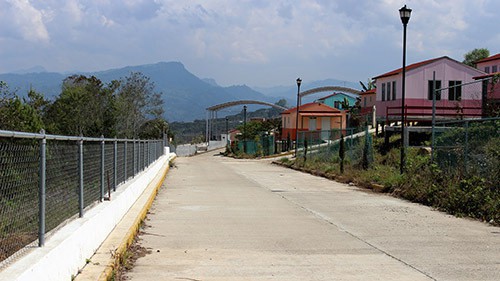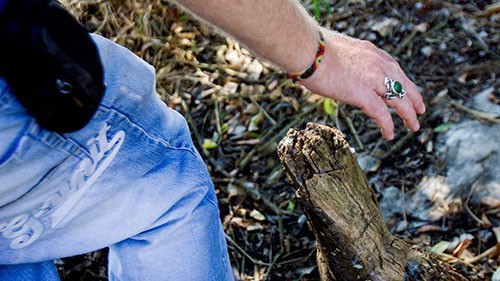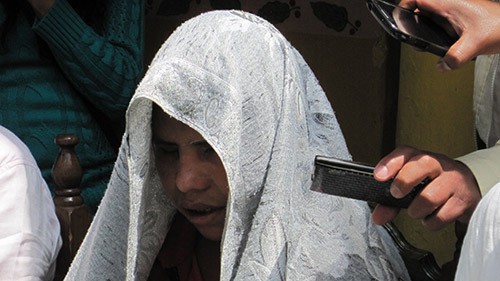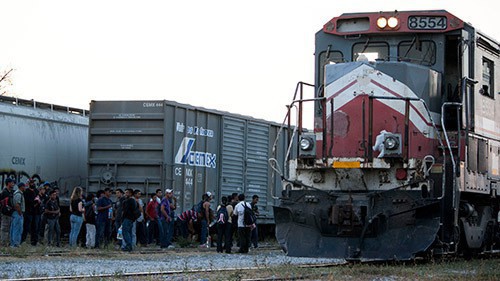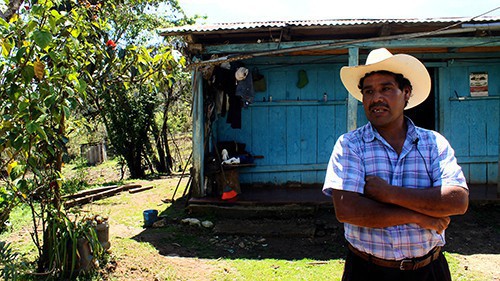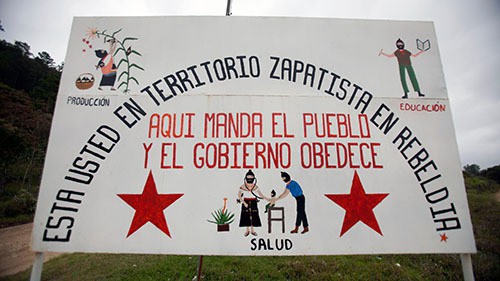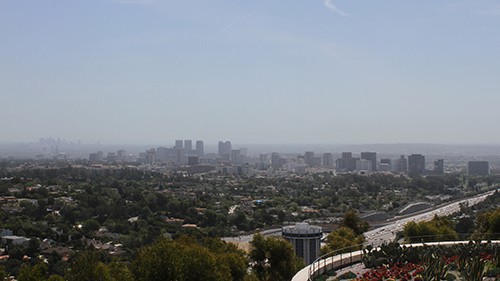
Along the route north, shelter operators heed calling to aid migrants
By Jessie Wardarski / Cronkite Borderlands Project
Published Sept. 25, 2014
ARRIAGA, Chiapas, Mexico – He’s not in it for money or self-gratification. He does it for migrants who have no voice, who are afraid to stand out in a country that’s not their own. He has dedicated his life to helping secure theirs.
Carlos Solis eats, sleeps and breathes the rights of Central American migrants who have illegally crossed the southern border of Mexico and reached his House of Mercy shelter in the dusty, rural city of Arriaga.
“I stay here. I sleep here. I spend close to 24 hours a day here,” Solis said.
Solis took over as director and sole fulltime employee about a year ago from the founder, the Rev. Heyman Vazquez, who now works in northern Chiapas shelters. Solis had been training under Father Vazquez to become a priest when he found his true calling in front of him at the shelter.
The tipping point, he said, was the abuse women suffer as they travel north.
“Women were raped and they had their husbands with them. So they were raped in front of them – or in other words one person was raping the wife and the other was holding the husband and making him watch, so he would see the act. And if he dared say anything they would just shoot him,” he said.
“So then, you ask yourself, where is the humanity? Because here we are talking about savagery,” Solis said. “So to listen to all these stories and these shameful things, then, yes, it moves you, and you say, ‘Well, something has to be done to change this situation.’”
His shelter is one of 52 scattered along the route migrants take through Mexico to the United States, said Mariana Echandi, spokeswoman for the United Nations High Commissioner for Refugees in Mexico.
The trek north once began farther south, near the Guatemala border, but rail damage wrought by Hurricane Stan in 2005 and Hurricane Barbara in 2013 made Arriaga the starting point for a freight train know “la bestia” – the Beast – or more ominously, “the Train of Death.”
The northbound train leaves here twice a week. On each journey, hundreds of people ride atop the freight cars, forced to hold on for hours, even days, to reach their destinations. Many are injured, Solis said, when they tire and fall off.
Injuries are severe. In Tapachula, 165 miles to the south, the Albergue Jesus Buen Pastor del Pobre y el Migrante shelter helps those who lost limbs or suffered other injuries falling off the train, were injured in attacks or who have chronic diseases.
“We’re used to treating tuberculosis, mutilations from arms or legs, bad wounds (cuts), very deep wounds from a knife or machete, bullet wounds and exposed parts when some of their flesh starts to rot and we have to start cutting all of the dead tissue,” said shelter director Aracy Sanchez, the daughter of its founder, in a telephone interview.
Sanchez said Tapachula has seen a 50 percent increase in migrants coming from Central America over the past 10 years. This town, near the border with Guatemala, is where “the beast” route used to begin.
“There have been three times as many people than there used to be and it’s worse because they have to walk” since the derailing of the beast, she said. “They come in groups and stay in Tapachula, and then they have to walk from Tapachula to Arriaga. They become victims of the authorities and organized crime.”
The financial struggle
A 2010 International Center for the Human Rights of Migrants study found 65 percent of Central American migrants were heading to the U.S., crossing Mexico en route. Despite the need, shelters like those run by Solis and Sanchez receive no government funding, relying heavily on donations that don’t always pay the bills.
When Sister Olga founded Albergue Jesus Buen Pastor del Pobre y el Migrante in 1990, she used her life savings to do it, Sanchez said. As the money ran low and her credit cards reached their limits, the shelter – which Sanchez calls the only “medical” migrant shelter in Mexico – began to fall deep into debt.
So Sister Olga and Sanchez started raising money by baking bread to sell at churches on Sundays. They sell doughnuts on the streets during the week; tacos and burgers at community events; chips, salsa and other items at the corner store Sister Olga opened.
It’s still not enough to pay the 45,000 pesos – $3,600 – owed to the electric company, much less the overall $50,000 debt. Power was cut off for 11 days in January over an 88,000 peso bill. They raised enough to get the power back after posting stories of their struggles on Facebook. But the focus remains on the humanitarian efforts, not the financial problems.
“We are helping with three surgeries now, providing surgical material. We are also helping three families with cancer; we are helping people who need medicine and exams,” Sanchez said, days after the power came back. “We prefer to buy surgical materials, food and medicine before paying the electricity bill.”
Like Solis at the House of Mercy in Arriaga, Sister Olga dedicates her life to the travelers. “Every day (she) gets up at 7 a.m. and goes to sleep at midnight,” Sanchez said.
But the risks can be more than just financial for shelter operators.
“Carlos has been threatened a lot; they are having him followed,” Sanchez said of Solis. “Here in Chiapas it has been very hard for him. He’s only been there for a year, but he’s been working hard just to keep going.”
Finding shelter
The House of Mercy is hard to miss. It’s one of the only finished, two-story, white buildings in Arriaga, on a street lined with unfinished and abandoned buildings, vacant lots and the look of a neighborhood that never had better days.
It’s advertised by word of mouth among migrants. About 10 percent of those looking to hop the train wait at the House of Mercy. Others at the shelter plan longer, costlier – but safer – journeys than a ride on the beast.
That alternative was the bus for Liceth Arely Merlos’ son and daughter, both still minors. Most of the journey from El Salvador was by bus, although the family got off at some points to avoid the authorities, walking for miles through sometimes mountainous terrain. Arriving in Arriaga at Solis’ shelter was their first resting point.
Not everyone is welcome at the House of Mercy. Coyotes – human smugglers – and the migrants who have paid them aren’t permitted. Solis doesn’t admit large groups traveling together – signs of a smuggling operation. He keeps the door padlocked around the clock.
Upon arrival at the shelter, men and women are separated, men to the right and women to the left, where each have common areas and dormitory-style rooms with bunk beds and mainly twin-sized foam mattresses.
The number of women and families migrating through Mexico is rising dramatically, but that wasn’t always the case. So the shelter is equipped for only about 20 women and children and 60 to 70 men. On most nights the shelter is nearly full, but immediately after the beast departs, it is close to empty.
On one day in March, volunteer worker Vladimir instinctively reached for the padlock keys and went to the front door where a small group of men was peering though the rusted red bars.
Vladimir let the men in, directing them to a small black sofa under a large painting of Jesus as he got a handheld metal detector. The men stood, one by one, to be scanned thoroughly before being allowed to enter.
Vladimir, 14, is himself a migrant, traveling with his younger sister and father. He was informally recruited by Solis as an “assistant” while the family figures out its next move. They had been there a month in March.
Vladimir and Daphne Van Der Werf, a volunteer visiting for three months from Holland, were Solis’ only regular helpers.
Even after more than two months at the shelter, Van Der Werf was still baffled at the risks the migrants take to escape the danger and poverty in their home countries.
“I still can’t figure out why they do this. How much danger and poverty can you have that you give up the safety of your own country, your own house and leave your family behind … to go on this dangerous route?” she asked.
The only option
Meybol del Rosario Rugama Urbina felt she had no choice. Several months pregnant, she said her partner in Nicaragua threatened to kill her unborn child, so she took her daughter, Paola, 6, and fled. In March, the two had been at House of Mercy for eight nights, a longer stay than most.
They began the journey with Rugama Urbina’s uncle and her 13-year-old brother, traveling more than 800 miles across the borders of Honduras, El Salvador and Guatemala before their bus was stopped by Mexican immigration authorities. The uncle and brother were asked to step out after questioning. Her uncle was immediately deported and her brother, as far as she knew, was still in a detention facility in southern Mexico.
Rugama Urbina and Paola reached the shelter in Arriaga, where they waited for the previously deported uncle to continue their journey north, hoping to meet Meybol’s mother in Indianapolis.
To earn their keep at the shelter, Rugama Urbina worked in the kitchen, cooking the three meals the migrants get each day. Everyone who stays at the House of Mercy is assigned some task as payment for the food and shelter they receive.
Every migrant’s name and personal information is entered into the shelter’s new computer, a way to document their existence along the perilous journey. Before Van Der Werf arrived and helped set up the computer in January, Solis was writing the names in a notebook.
Migrants also are asked if they have any abuses to report. Complaints are taken to the local prosecutor where, on occasion, cases go to trial. But Solis said charges are often dropped: The process is long and hard to prove, and the migrants need to move north.
The shelter reports, on average, one complaint a month to the local prosecutor’s office in Arriaga. Last year, about 50 cases were carried through fully.
A spartan oasis
The men’s and women’s quarters in the shelter are equally sparse.
The men’s common area is in a half-enclosed courtyard. A single couch tearing at the seams is against one wall and a large television is mounted on the opposite wall. Men lay shirtless with hands folded behind their heads on the thin foam mattresses, watching television while their clothes and shoes dry in the sun. They drape their clothes over tall metal poles in the uncovered portion of the courtyard, and soaking shoes lean against a concrete wall.
If he had the money Solis would turn the unfinished portion of the shelter into a theater for those who come to stay. But that dream is not likely to become reality soon.
The men’s sleeping quarters take up the second floor. Four rows of wooden bunk beds fill the room, which is connected to a narrow restroom lined with several urinals and toilets with no doors, that are flushed once a day with a bucket of water.
On the other end of the building, the women and children can lounge on pair of mismatched couches that face each other. In between is a short, wooden table strewn with pamphlets on human rights and migrant aid. The back wall has three chairs, one plastic and two made of old, tattered wood, that sit opposite a large silver TV on a plastic fold-out table.
Next to this room is where the women sleep. There are two rows of twin bunk beds and three larger beds with spring mattresses, many with similar brown stains. Unlike the men, who are given a single sheet each night before bed, the women have to reuse the sheets already on the mattresses.
The women have a modicum of privacy not afforded the men; a shower curtain separates two small toilets without seat covers and no water to flush. Next to them is a tiled washtub. Large plastic buckets of water sit on the floor, which the women use to douse and clean themselves, letting the water fall to the floor.
With its higher ceilings, this room is also used for storage. Piles of foam mattresses fill one corner from floor to ceiling. Alongside the mattresses, clothes sit in mounds, unfolded, for the migrants to use when washing their own clotehs. The women have two clotheslines made of string that hang in a small alley-like space just outside their room.
There is no air conditioning, regular plumbing or washing machines. In U.S. terms, it’s not quite up to code, but for the migrants it’s an oasis.
And for Solis, his eyes underscored by dark bags, it remains a place with a purpose.
“The objective is to keep fighting for an immigration with dignity, justice, and above all free of violence for the Central American immigrants,” he said.

